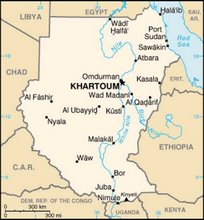 On Saturday, we rented a car and paid a driver to drive us up to Meroe and Musawwarat es Sufra, ancient Meroitic sites dating back to about 500 BC to 500 AD when Meroe became the capital of the Kushite Kingdom. Meroe, which is approximately 4 hours north of Khartoum, is the site of the Royal City and Royal cemetery, or pyramids.
On Saturday, we rented a car and paid a driver to drive us up to Meroe and Musawwarat es Sufra, ancient Meroitic sites dating back to about 500 BC to 500 AD when Meroe became the capital of the Kushite Kingdom. Meroe, which is approximately 4 hours north of Khartoum, is the site of the Royal City and Royal cemetery, or pyramids.We went first to the pyramids. We rode camels up to the base of the pyramids and spent an hour walking around and exploring. Originally, there were 57 pyramids in the cemetery, but hundreds of years of sand and wind and robbers seeking treasures have decapitated and destroyed most of ruins. Most of the gold found in these pyramids eventually found it’s way to Egyptian museums in Berlin and Munich.
After visiting Meroe, we headed back south and then drove straight east across the desert to Musawwarat es Sufra, site of the largest Merotic remains in the Sudan, and in my opinion, the most impressive. These sites can only be reached if you have an experienced driver or GPS, as we drove approximately 45 km across the desert to reach these ruins. The large complex of remains at Musawwarat is called the “Great Enclosure.” At the center of the sprawling compound is a large temple. All of the walls and columns are covered in elephants, Egyptian carvings and hieroglyphics. It is unclear how this site was used; some hypothesize that it was a training ground for war and a place where prisoners were housed, while others surmise that it was a pilgrimage site dedicated to the God Apedemak.


No comments:
Post a Comment